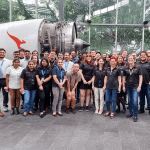Managing an IT operation is much like coaching a new footy team. Each player drafted into the team has their own history, unique playing style; strengths and weaknesses.
They’re all at the top of their game, but that doesn’t automatically make them a winning team. If your IT operations are a footy team, then Service Integration and Management (SIAM) is the playbook that helps the coaches bring players together, ensuring they work as a cohesive unit toward a common goal.
What is SIAM?
Originating from the need for a unified approach in IT management, SIAM ensures that diverse service providers work in harmony, making the entire operation as seamless as a well-coordinated team on the field. As Simon Dorst, a global expert in SIAM and Kinetic IT’s Director of Service Management Education explains:
“SIAM is essential in the modern IT environment where multiple service providers must collaborate to deliver cohesive and efficient services. The need for SIAM is growing in Australia, particularly in the government sector, where the complexity of IT environments requires more sophisticated management approaches.”
The SIAM ecosystem explained
There are many key roles in the SIAM ecosystem that need to work together for the playbook to become a winning footy strategy:
Service Providers or “The Players”
Service providers are the vendors who deliver IT services to the customer. They manage the products, technologies and processes they need to deliver their services.
Customer Organisation or “The Club”
The customer organisation is the end client which owns the contractual relationships with any external service providers and the service integrator. Customer organisations typically contain business units such as human resources, finance, sales and their own internal IT function.
Service Integrator or “The Coach”
A service integrator is the entity responsible for the end-to-end delivery of IT services for the customer organisation. Service integration, whether provided by a single head coach or a team of coaches, is the linchpin of SIAM. Service integrators have a direct relationship with both the customer and all the service providers. Where a coach oversees the day-to-day operations at their footy club, a service integrator has operational governance over the whole SIAM ecosystem.
In simple terms, it’s up to the service integrator to organise all the providers in the team and make sure they’re delivering value back to the customer organisation.
End Users or “The Fans”
You can’t have a club without the fans. As the end users or customers of the customer organisation, the fans benefit from the successful delivery of integrated IT services.
DOWNLOAD INSIGHTS: The SIAM archetypes whitepaper
SIAM & ITSM: What’s the difference?
ITSM (IT Service Management) is like the day-to-day coaching that prepares each player for the game, focusing on developing the skills, strategies, and readiness within the team. ITSM and SIAM aren’t mutually exclusive—SIAM builds on ITSM’s foundations by managing the complexities of working with multiple service providers, ensuring that all those efforts align to achieve the team’s goals.
While ITSM optimises IT services within one provider, SIAM coordinates and governs different vendors to ensure they work together smoothly.
This approach is especially relevant in Australia, where businesses often rely on a mix of local and global partners to deliver cohesive IT solutions in today’s interconnected landscape.
RELATED CONTENT: SIAM – a strategic advantage for government CIOs
What is ITIL and how does it work with SIAM?
ITIL provides a best-practice framework for IT Service Management, with detailed guidelines on processes like Incident Management, Change Management, and Service Delivery.
If SIAM is the footy playbook that coordinates the entire team, ensuring everyone knows their role and works together seamlessly, ITIL is like the training drills and strategies each player must master. ITIL teaches the techniques—how to pass, tackle, and execute plays—while SIAM brings it all together on game day, making sure every player (or service provider) is in sync to win the match.
DOWNLOAD RESOURCE: ITIL & SIAM process assessment fact sheet
Imagine an Australian government department working with multiple IT service providers to deliver cloud infrastructure, cybersecurity, and user support across multiple states. ITIL would guide each provider on handling incidents, managing changes, and delivering services consistently. SIAM would then provide the framework to coordinate these providers. In practice this would mean that a server issue in Sydney is resolved with the same urgency and process as in Perth.
Together, SIAM and ITIL ensure that all providers understand the rules of the game and can deliver a seamless experience to users across Australia, from major cities to remote areas.
RELATED CONTENT: Service management assessment – a guide to getting it right
What are the 4 SIAM models?
There are four common approaches to structuring a Service Integration and Management (SIAM) ecosystem: externally sourced, internally sourced, hybrid, and lead supplier. Each one offers a unique way of configuring the service integrator layer, depending on factors such as business needs, organisational size, internal capabilities, and risk appetite.
- Externally Sourced SIAM Model: Externally Sourced SIAM is ideal if your organisation doesn’t have the internal skills or resources for service integration and doesn’t plan to develop them. In this case, a third party takes on the service integrator role, managing the day-to-day coordination of service providers. It works best for organisations that are comfortable trusting an external partner to handle the intricacies of service integration while maintaining strong governance to ensure everything aligns with their strategic goals.
- Internally Source SIAM Model: Internally Sourced SIAM is excellent for organisations that possess the skills and resources to manage their service integration. It allows you to retain complete control and flexibility, but it does come with the long-term challenge of maintaining that capability. The benefits? You have full ownership, fewer contractual headaches, and no dependency on an external party. However, this does require SIAM skills and isn’t a great option if these are lacking within the organisation. Remember, SIAM skills are not just service management skills; they also require relationship management, organisational change management, and commercial acumen, to name a few.
- Hybrid SIAM Model: Hybrid SIAM offers a flexible model that combines the best of both worlds. It’s a collaborative approach where the customer organisation and an external service integrator partner share responsibility. This setup empowers companies to build their in-house capabilities over time while still benefiting from external expertise.
- Lead Supplier SIAM Model: Lead Supplier SIAM is where the organisation taking on the service integrator role also performs the activities of service providers and delivers services. This setup is worthwhile when you already have a trusted service provider who can step up to the service integrator role. However, it can sometimes lead to perceived conflicts of interest, so clear boundaries and governance are critical.
Each of these structures has its advantages and drawbacks. However, choosing the approach that best aligns with your organisation’s goals, capabilities, and risk tolerance is key to a successful SIAM ecosystem. This strategic alignment will guide your decision-making process and ensure the best outcomes for your organisation.
What are the benefits of SIAM?
- Improved service quality: SIAM keeps everything coordinated, ensuring all service providers consistently deliver high-quality results and bring home trophies.
- Efficiency gains: By cutting out unnecessary steps, optimising workflows and aligning efforts, SIAM helps organisations operate more smoothly and efficiently.
- Cost optimisation: Managing resources wisely through SIAM allows organisations to get a better return on investment (ROI) from their service providers.
- Better visibility and control: SIAM provides clear oversight of all service providers, so that key decision makers have greater operational governance and the ability to manage complex IT landscapes effectively.
- Increased agility: The ability to respond rapidly to changes is a key benefit of SIAM, helping organisations stay flexible and competitive.
- Improved vendor accountability: SIAM holds every service provider to the same high standards, ensuring that everyone stays on track and meets expectations.
- Seamless Integration of Services: SIAM ensures that all services work together seamlessly, fostering a cohesive and unified experience for end users.
- Scalability: As an organisation grows, SIAM facilitates the expansion of services and effective change management, allowing for growth without compromising quality.
- Reduced Risk: With better oversight and coordination, SIAM enables effective incident response management by minmising the risks associated with service delivery, protecting organisations from potential disruptions.
RELATED CONTENT: SIAM saves money and more
Common challenges when adopting SIAM
SIAM isn’t without challenges, not the least of which is getting buy-in from every employee at the footy club. If you want to know the fastest way to make an enemy, try to change something.
Here are some of the common challenges we see:
- Cultural Resistance: When a club hires a coach, it can take some time before everyone gets with the new program. Similarly, bringing different organisational cultures together can be tough. Generally speaking, people don’t like change – even if that change benefits them in the long run.
- Lack of Standardisation: When service providers have different ways of managing their tasks, it can lead to confusion and disorganisation, similar to players not knowing their positions on the field. Without clear standards, it’s hard to keep everything running smoothly.
- Vendor Management: Handling the relationships between vendors can take careful coordination and flexible communication. Even the best teams sometimes have difficult personalities that need to be managed in order to keep everyone on the same page and working towards the same goal.
Practical approaches for effective SIAM
The importance of organisational change management (OCM)
Organisational Change Management (OCM) is crucial to the success of SIAM because the effectiveness of any change hinges on user perception and buy-in. More than 84% of respondents to the 2023 Global SIAM Survey by Scopism ranked OCM as the number one skill required for SIAM success.
DOWNLOAD INSIGHTS: Global SIAM 5-Year Survey Whitepaper
Implementing SIAM often requires significant changes in processes, workflows, and user behaviour across multiple departments. Without strong communication, even the best technical solutions can fail if users aren’t on board. A well-executed communication strategy ensures that everyone—from executives to frontline staff—understands the changes, why they’re necessary, and how they’ll benefit the organisation. This approach fosters a positive perception of change, motivating employees to adopt new ways of working and ensuring the SIAM initiative delivers its full potential.
Service influencing for effective service management
Service influencing in SIAM involves guiding vendors to work together effectively, despite their differences. It’s about fostering a collaborative “one team” mindset among service providers. By influencing how vendors interact and align with organisational goals, the Service Integrator ensures smoother vendor management and better overall service delivery. This approach helps create a more unified, efficient service environment where all providers are working toward the same objectives.
RELATED CONTENT: Service Influence: The essential service integration and management skill
The future of SIAM: trends & predictions
The future of SIAM is promising, with trends like artificial intelligence (AI) integration and the evolution of SIAM Bodies-of-Knowledge. As Simon Dorst highlights, “AI can enhance the integration and communication within SIAM environments, but it needs to be implemented judiciously, considering aspects like cost, security, and social responsibility.”
The responsible adoption of AI alongside frameworks like SIAM is also something that the Australian Digital Transformation Agency is keeping a close eye on, with the implementation of standards to help Australian Public Service (APS) agencies stay accountable.
RELATED CONTENT: What’s trending in SIAM
Another emerging trend is the application of SIAM principles beyond IT, into areas like Enterprise Service Management (eSM), promising larger, more complex implementations across entire organisations.
Automation is set to play a crucial role in streamlining SIAM processes for large enterprises, reducing manual tasks, and enhancing service efficiency. For Australian organisations, this means optimising resources and maintaining high service standards in an increasingly competitive market.
Employee experience is equally important, focusing on making tools and processes more user-friendly and supportive. By ensuring a seamless experience across different service providers, organisations can boost productivity and job satisfaction, ultimately leading to better service outcomes.
Discover our SIAM services.
As a trusted local partner for Australian organisations, we can transform your digital service delivery and help your customers thrive.















